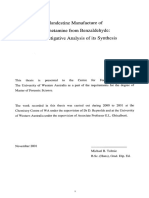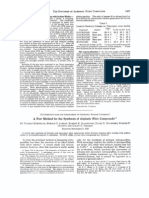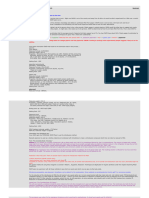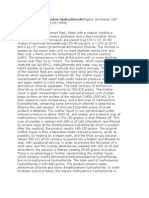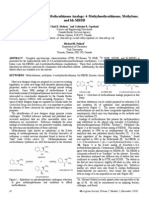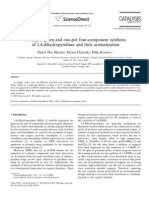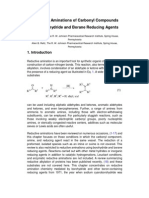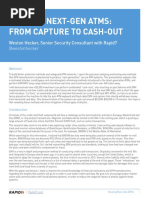0 ratings0% found this document useful (0 votes)
PCP Tek
PCP Tek
Uploaded by
gnarly tiredThis document provides two methods for synthesizing phenylcyclohexylpiperidine or analogs from readily available starting materials. Method 1 involves reacting cyclohexanone with ethylamine to form an intermediate, which is then reacted with phenyllithium. Method 2 involves reacting cyclohexylamine and piperidine to form a cyclohexenyl-piperidine intermediate, which is then reacted with benzyl magnesium bromide. Both methods conclude by converting the free base product to its hydrochloride salt for isolation.
Copyright:
© All Rights Reserved
Available Formats
Download as TXT, PDF, TXT or read online from Scribd
Download as txt, pdf, or txt
PCP Tek
PCP Tek
Uploaded by
gnarly tired0 ratings0% found this document useful (0 votes)
This document provides two methods for synthesizing phenylcyclohexylpiperidine or analogs from readily available starting materials. Method 1 involves reacting cyclohexanone with ethylamine to form an intermediate, which is then reacted with phenyllithium. Method 2 involves reacting cyclohexylamine and piperidine to form a cyclohexenyl-piperidine intermediate, which is then reacted with benzyl magnesium bromide. Both methods conclude by converting the free base product to its hydrochloride salt for isolation.
Original Description:
pcp tek
Original Title
pcp tek
Copyright
© © All Rights Reserved
Available Formats
TXT, PDF, TXT or read online from Scribd
Share this document
Did you find this document useful?
Is this content inappropriate?
This document provides two methods for synthesizing phenylcyclohexylpiperidine or analogs from readily available starting materials. Method 1 involves reacting cyclohexanone with ethylamine to form an intermediate, which is then reacted with phenyllithium. Method 2 involves reacting cyclohexylamine and piperidine to form a cyclohexenyl-piperidine intermediate, which is then reacted with benzyl magnesium bromide. Both methods conclude by converting the free base product to its hydrochloride salt for isolation.
Copyright:
© All Rights Reserved
Available Formats
Download as TXT, PDF, TXT or read online from Scribd
Download as txt, pdf, or txt
0 ratings0% found this document useful (0 votes)
PCP Tek
PCP Tek
Uploaded by
gnarly tiredThis document provides two methods for synthesizing phenylcyclohexylpiperidine or analogs from readily available starting materials. Method 1 involves reacting cyclohexanone with ethylamine to form an intermediate, which is then reacted with phenyllithium. Method 2 involves reacting cyclohexylamine and piperidine to form a cyclohexenyl-piperidine intermediate, which is then reacted with benzyl magnesium bromide. Both methods conclude by converting the free base product to its hydrochloride salt for isolation.
Copyright:
© All Rights Reserved
Available Formats
Download as TXT, PDF, TXT or read online from Scribd
Download as txt, pdf, or txt
You are on page 1/ 1
? PCP TEK ?
Looks like you found a gap in the market. Get cooking!
"METHOD 1. A mixture of 100 g of anhydrous ethylamine and 220 g of cyclohexanone is
kept 16 hours,
shaken with solid KOH, and the oil layer is removed by decantation. Distill the oil
layer in vacuo to
get the intermediate N-cyclohexylidenethylamine. Prepare a mixture of phenyllithium
by mixing 11 g of
lithium and 76 ml PhBr in 500 ml of Et20. Add the phenyllithium dropwise to a
solution of 51 g of the
N-cyclohexylidenethylamine in 500 ml of Et20, with stirring and cooling, to keep
the temp at 0�. Stir
for one hour and then decompose by adding water. Separate the Et20 layer, wash with
H20 and distill to
get 1-phenylcyclohexylethylamine or analog. The hydrochloride form is obtained in
the usual way, as
given below.
METHOD 2. A mixture of 170 g of piperidine, 220 g of cyclohexylamine, and 750 ml of
benzene is azeotropically
distilled until the evolution of H20 stops, then vacuum distill to get
cyclohexenyl-piperidine.
p-toluenesulfonic acid monohydrate (190 g) in 250 ml of PhMe is heated under a
water trap until all
the H20 is removed, then add a solution of 165 g of cyclohexyl-piperidine in 500 ml
of Et20, with cooling,
to keep temp at 0�. A solution of I mole of PhMgBr (made from 157 g of PhBr and 24
g of Mg) in 750 ml of
Et20 is added (still holding the temp at 0� to 5�). The mixture is stirred for an
additional 30 min after
the dropwise addition is complete. Decompose the mixture by adding an excess
saturated NH4Cl and NH40H.
The Et20 layer is removed, dried over K2CO3, and distilled to give
phenylcyclohexylpiperidine. Convert to
the hydrochloride form by dissolving the free base in an excess of iso-PrOH-HC1 and
then precipitate the
salt (the hydrochloride) with Et20 and crystallize from Et20-iso-PrOH (this is a
mixture). "
You might also like
- Short Communication - A Novel Synthesis of 3 4-Methylenedioxyphenyl-2-Propanone MDP2P From Helional100% (1)Short Communication - A Novel Synthesis of 3 4-Methylenedioxyphenyl-2-Propanone MDP2P From Helional3 pages
- Easy Oxidation of THF To GBL, Hive Novel Discourse100% (1)Easy Oxidation of THF To GBL, Hive Novel Discourse20 pages
- MDP2NP 2-HEAA Catalysed Henry Condensation of PiperonalNo ratings yetMDP2NP 2-HEAA Catalysed Henry Condensation of Piperonal20 pages
- A Facile and Improved Synthesis of DesomorphineNo ratings yetA Facile and Improved Synthesis of Desomorphine4 pages
- Reductive Methylation of Primary and Secondary Amines and Amino Acids by Aqueous Formaldehyde and Zinc100% (1)Reductive Methylation of Primary and Secondary Amines and Amino Acids by Aqueous Formaldehyde and Zinc3 pages
- A New Method For The Synthesis of Aliphatic Nitro Compounds1, 2No ratings yetA New Method For The Synthesis of Aliphatic Nitro Compounds1, 25 pages
- A Convenient Way To Synthesis of Analgesic TramadolNo ratings yetA Convenient Way To Synthesis of Analgesic Tramadol1 page
- Ritter's Writeup of This Method in Total Synthesis II: A Photo-Essay by Dr. Gonzo Using This Method Can Be Found100% (1)Ritter's Writeup of This Method in Total Synthesis II: A Photo-Essay by Dr. Gonzo Using This Method Can Be Found6 pages
- Preparation of Clonazepam and ClonitrazolamNo ratings yetPreparation of Clonazepam and Clonitrazolam3 pages
- P2NP-derivation To The Alternative ApproachNo ratings yetP2NP-derivation To The Alternative Approach3 pages
- R12ii - A Review of Impurity Profiling and Synthetic RouteNo ratings yetR12ii - A Review of Impurity Profiling and Synthetic Route19 pages
- P2P From Nutra Sweet - Ewok - Poacher - Downlowd Synthetikal - Org Sept (2007) PDFNo ratings yetP2P From Nutra Sweet - Ewok - Poacher - Downlowd Synthetikal - Org Sept (2007) PDF3 pages
- Characterization of 3 Methcathinone Analogs Mephedrone, Methylone, BK-MBDBNo ratings yetCharacterization of 3 Methcathinone Analogs Mephedrone, Methylone, BK-MBDB8 pages
- Bbgate Com Threads Synthesis of Methamphetamine From p2p and Nabh4 Reduction 9731No ratings yetBbgate Com Threads Synthesis of Methamphetamine From p2p and Nabh4 Reduction 973112 pages
- Illicit Synthesis of Phencyclidine (PCP)No ratings yetIllicit Synthesis of Phencyclidine (PCP)8 pages
- Pseudoephedrine: 1. Synonyms CFR: Nist #No ratings yetPseudoephedrine: 1. Synonyms CFR: Nist #18 pages
- Preparation of MDMA by Reductive Amination With Sodium Borohydri PDFNo ratings yetPreparation of MDMA by Reductive Amination With Sodium Borohydri PDF5 pages
- Solvent Free Reduction of Aromatic Nitro Compounds With Alumina Supported Iron Powder and Acetic Acid Under Microwave IrradiationNo ratings yetSolvent Free Reduction of Aromatic Nitro Compounds With Alumina Supported Iron Powder and Acetic Acid Under Microwave Irradiation5 pages
- Paul Loo - Convenient Synthesis and Spectroscopic Data of Methcathinone Analogs100% (2)Paul Loo - Convenient Synthesis and Spectroscopic Data of Methcathinone Analogs27 pages
- Improved Procedure For The Preparation of 1 - (2-Phenethyl) - 4-PiperidoneNo ratings yetImproved Procedure For The Preparation of 1 - (2-Phenethyl) - 4-Piperidone5 pages
- A-Phenylethylamine in Illegally Produced Amphetamine: Dariusz Bøachut, Zbigniew Czarnocki, Krystyna WojtasiewiczNo ratings yetA-Phenylethylamine in Illegally Produced Amphetamine: Dariusz Bøachut, Zbigniew Czarnocki, Krystyna Wojtasiewicz9 pages
- A Simple, Green and One-Pot Four-Component Synthesis of 1,4-Dihydropyridines and Their AromatizationNo ratings yetA Simple, Green and One-Pot Four-Component Synthesis of 1,4-Dihydropyridines and Their Aromatization6 pages
- Universal Extraction Technique - Straight To BeeNo ratings yetUniversal Extraction Technique - Straight To Bee7 pages
- Reductive Amination of Carbonyl Compounds With Borohydride and BoranNo ratings yetReductive Amination of Carbonyl Compounds With Borohydride and Boran170 pages
- Microwave Assisted Chemistry Experiments: (Organic Synthesis, Chemical analysis and Extraction)From EverandMicrowave Assisted Chemistry Experiments: (Organic Synthesis, Chemical analysis and Extraction)No ratings yet
- Organic Syntheses / An Annual Publication of Satisfactory Methods for the Preparation of Organic ChemicalsFrom EverandOrganic Syntheses / An Annual Publication of Satisfactory Methods for the Preparation of Organic ChemicalsNo ratings yet
- Oxazoles: Synthesis, Reactions, and Spectroscopy, Part AFrom EverandOxazoles: Synthesis, Reactions, and Spectroscopy, Part ADavid C. PalmerNo ratings yet
- Young's Demonstrative Translation of Scientific Secrets Or, A Collection of Above 500 Useful Receipts on a Variety of SubjectsFrom EverandYoung's Demonstrative Translation of Scientific Secrets Or, A Collection of Above 500 Useful Receipts on a Variety of SubjectsNo ratings yet
- Movietitle Year Genre Rating Length Director Writer Unforgiven 1992 Western R 131 Clint Eastwood David Webb PeeblesNo ratings yetMovietitle Year Genre Rating Length Director Writer Unforgiven 1992 Western R 131 Clint Eastwood David Webb Peebles2 pages
- Website Address Setup Date Customer Name & Company Username (Yahoo & DC)100% (1)Website Address Setup Date Customer Name & Company Username (Yahoo & DC)15 pages
- Godaddy Opennrm Netsol 34north, BDL Netsol 32419586 Fu3J9087! 1234:lokid 0P3Nnrm34!No ratings yetGodaddy Opennrm Netsol 34north, BDL Netsol 32419586 Fu3J9087! 1234:lokid 0P3Nnrm34!10 pages
- Us 16 Hecker Hacking Next Gen ATMs From Capture To CashoutNo ratings yetUs 16 Hecker Hacking Next Gen ATMs From Capture To Cashout6 pages
- Raspberry Pi The Complete Manual 6th Ed - 2016 UK PDFNo ratings yetRaspberry Pi The Complete Manual 6th Ed - 2016 UK PDF132 pages
- CDSDHD County State Reg First Last SFX Sex Birth YearNo ratings yetCDSDHD County State Reg First Last SFX Sex Birth Year606 pages






